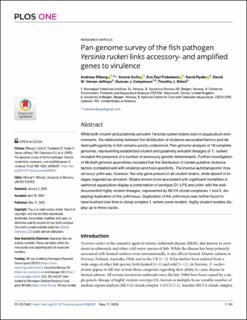| dc.contributor.author | Riborg, Andreas Ekroll | |
| dc.contributor.author | Gulla, Snorre | |
| dc.contributor.author | Fiskebeck, Eve Marie Louise Zeyl | |
| dc.contributor.author | Ryder, David | |
| dc.contributor.author | Verner-Jeffreys, David W. | |
| dc.contributor.author | Colquhoun, Duncan John | |
| dc.contributor.author | Welch, Timothy J. | |
| dc.date.accessioned | 2024-03-11T10:09:24Z | |
| dc.date.available | 2024-03-11T10:09:24Z | |
| dc.date.created | 2023-06-02T18:34:43Z | |
| dc.date.issued | 2023 | |
| dc.identifier.issn | 1932-6203 | |
| dc.identifier.uri | https://hdl.handle.net/11250/3121757 | |
| dc.description.abstract | While both virulent and putatively avirulent Yersinia ruckeri strains exist in aquaculture environments, the relationship between the distribution of virulence-associated factors and de facto pathogenicity in fish remains poorly understood. Pan-genome analysis of 18 complete genomes, representing established virulent and putatively avirulent lineages of Y. ruckeri, revealed the presence of a number of accessory genetic determinants. Further investigation of 68 draft genome assemblies revealed that the distribution of certain putative virulence factors correlated well with virulence and host-specificity. The inverse-autotransporter invasin locus yrIlm was, however, the only gene present in all virulent strains, while absent in lineages regarded as avirulent. Strains known to be associated with significant mortalities in salmonid aquaculture display a combination of serotype O1-LPS and yrIlm, with the well-documented highly virulent lineages, represented by MLVA clonal complexes 1 and 2, displaying duplication of the yrIlm locus. Duplication of the yrIlm locus was further found to have evolved over time in clonal complex 1, where some modern, highly virulent isolates display up to three copies. | en_US |
| dc.language.iso | eng | en_US |
| dc.publisher | PLoS | en_US |
| dc.rights | CC0 1.0 Universal | * |
| dc.rights.uri | https://creativecommons.org/publicdomain/zero/1.0/ | * |
| dc.title | Pan-genome survey of the fish pathogen Yersinia ruckeri links accessory- and amplified genes to virulence | en_US |
| dc.type | Journal article | en_US |
| dc.type | Peer reviewed | en_US |
| dc.description.version | publishedVersion | en_US |
| dc.rights.holder | No Copyright | en_US |
| dc.source.articlenumber | e0285257 | en_US |
| cristin.ispublished | true | |
| cristin.fulltext | original | |
| cristin.qualitycode | 1 | |
| dc.identifier.doi | 10.1371/journal.pone.0285257 | |
| dc.identifier.cristin | 2151439 | |
| dc.source.journal | PLOS ONE | en_US |
| dc.identifier.citation | PLOS ONE. 2023, 18 (5), e0285257. | en_US |
| dc.source.volume | 18 | en_US |
| dc.source.issue | 5 | en_US |

